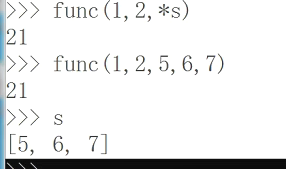多个参数定义函数
>>> def print_sth(s1,s2,s3):
... print(s1,s2,s3)
...
>>> print_sth(1,2,3)
1 2 3
>>> print_sth("a","b","c")
a b c
>>> print_sth(s3="c",s2="b",s1="a")
a b c
C:Usersliuwe>python
Python 3.6.5 (v3.6.5:f59c0932b4, Mar 28 2018, 17:00:18) [MSC v.1900 64 bit (AMD64)] on win32
Type "help", "copyright", "credits" or "license" for more information.
>>> def print_sth(s1,s2,s3):
... print(s1,s2,s3)
...
>>> print_sth(s3="c",s2="b",s1="a")
a b c
命名参数必须在非命名参数的后面
>>> print_sth("c",s3="b",s2="a")
c a b
>>>定义多个参数没有使用
>>> def print_sth(s1,s2,s3):
... print("hello")
...
>>> print_sth(1,2,3)
hello
>>> print_sth(1,2,3)
hello
>>> def print_sth(s1,s2,s3):
... print(s1,s2,s3)
...
>>> print_sth(1,2,3)
1 2 3
>>> print_sth("a","b","c")
a b c
>>> print(print_sth())
None
>>> def print_sth():
... return "hello"
...
>>> print(print_sth())
hello
>>> def return_sth(s):
... return s
...
>>> print(return_sth(1))
1
>>> print(return_sth("a"))
a
>>> def return_sth(s):
... return s
...
>>> print(return_sth([1,2,3]))
[1, 2, 3]
函数无法返回多个数值,都是放在容器里返回
>>> def return_sth(s):
... return s
...
>>> print(return_sth([1,2,3]))
[1, 2, 3]
>>> def return_sth(s1,s2):
... return s1,s2
...
>>> print(return_sth(1,2))
(1, 2)
>>>
>>> a=100
>>> def func():
... print(a)
...
>>> func()
100
>>> func()
100
>>> del a
>>> func()
Traceback (most recent call last):
File "<stdin>", line 1, in <module>
File "<stdin>", line 2, in func
NameError: name 'a' is not defined
>>>函数里面取值,里面找不到就去外面找值
>>> def func():
... global a
... a=a+1
... print(a)
...
>>> func()
101
>>>参数不可变
>>> a=100
>>> def func(s):
... s=s+1
... return s
...
>>> print(a)
100
>>> print(func(a))
101
>>> print(a)
100
>>> a=100
>>> def func(s):
... s=s+1
... return s
...
>>> print(a)
100
>>> print(func(a))
101
>>>参数为不可变类型,函数内部计算生效,外部不变
>>> s="abc"
>>> def func(s):
... s=s+"d"
... return s
...
>>> print(func(s))
abcd
>>> print(s)
abc
>>>可变类型传参如下
>>> l=[1,2,3]
>>> def func(s):
... s.append(4)
... return s
>>> print(func(l))
[1, 2, 3, 4]
>>> print(l)
[1, 2, 3, 4]
>>> l=[1,2,3]
>>> new_l=l[:]
>>> new_l
[1, 2, 3]
>>> func(new_l)
[1, 2, 3, 4]
>>> l
[1, 2, 3]
>>>传递可变参数的时候,不想影响到外部的变量,就如上方法
》》函数默认值如下
>>> def func(a=100):
... print(a)
...
>>> func()
100
>>> func(200)
200
>>>
>>> def func(a=100,b):
... print(a,b)
...
File "<stdin>", line 1
SyntaxError: non-default argument follows default argument
默认值参数必须在非默认值后面
>>> def func(b,a=100):
... print(b,a)
...
>>> func(1)
1 100
>>> func(1,200)
1 200
>>>
>>> def func(a,b,*c):
... print(a)
... print(b)
... print(type(c))
... print(c)
...
>>> func(1,2,3,4,5,6,7,8,9)
1
2
<class 'tuple'>
(3, 4, 5, 6, 7, 8, 9)
>>>*是元组,把不定长参数传入到元组里供函数使用
>>> def func(a,b,*c):
... result=0
... result+=a
... result+=b
... for i in c:
... result+=i
... return result
...
>>> func(1,2)
3
>>> func(1,2,3)
6
>>> func(1,2,3,4)
10
>>> func(1,2,3,4,5)
15
>>>可变:list set,dict
不可变:数字,字符串,元组
>>> def func(a,b,**d):
... print(a,b)
... print(type(d))
... print(d)
...
>>> func(1,2,m=3,n=4,x=5)
1 2
<class 'dict'>
{'m': 3, 'n': 4, 'x': 5}
>>>用**d,求一下所有参数中的数字的和
def func(a,b,*c,**d):
result=0
result+=a
result+=b
for i in c:
result+=i
for i in d.values():
result+=i
return result
funct(1,2,3,4,m=5,n=6)


>>> y=lambda x:x+1
>>> y
<function <lambda> at 0x00000297D33998C8>
>>> y(1)
2
>>>